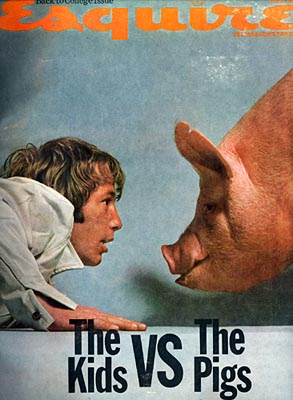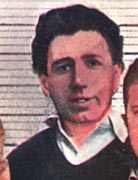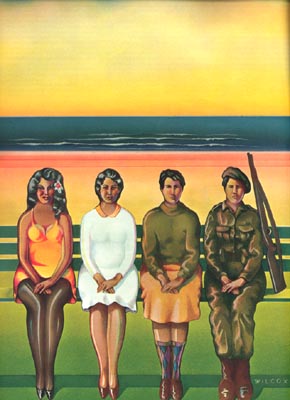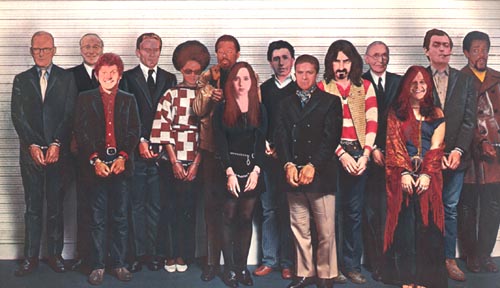Esquire, Sept. 1969.
Back to College Issue. vol. LXXI, no. 3, whole no. 420.
"Ringing out the Old in Happy Havana"
 This story was not included in Long Time Coming
and a Long Time Gone, so I thought I'd present some information on it
here. Esquire had a tradition of publishing a special "Back to College Issue"
every September, and for its September 1966 issue they had planned to feature an
essay by Fariņa on the contemporary college scene. Fariņa's death in April
of that year prevented Esquire from publishing anything by Fariņa,
but they did manage to persuade Joan Baez to write a commemorative essay on
her deceased brother-in-law.
This story was not included in Long Time Coming
and a Long Time Gone, so I thought I'd present some information on it
here. Esquire had a tradition of publishing a special "Back to College Issue"
every September, and for its September 1966 issue they had planned to feature an
essay by Fariņa on the contemporary college scene. Fariņa's death in April
of that year prevented Esquire from publishing anything by Fariņa,
but they did manage to persuade Joan Baez to write a commemorative essay on
her deceased brother-in-law.
Three years later Esquire finally got the chance
to feature Fariņa's writing in a college issue, although, as it turns out,
there was no collegiate theme in "Ringing out the Old in Happy Havana."
Plot Summary:
The story is set
in Cuba and is narrated by an American fisherman. He
has a painter friend whom he knew in Korea (perhaps based loosely on Eric
Von Schmidt, who sometimes provided Fariņa with his own war stories?). The
narrative
drifts back and forth from an earlier visit to Cuba in 1956, when
"everything was legal," to the present, which is difficult to date exactly,
but must be after Castro's revolution in the late fifties and of course
before Fariņa's death in 1966
(I have no information on when the story was written). The earlier visit
to Cuba involved a couple of women whom the narrator invited to join him and
his painter friend to dinner, while the present time, post-revolution, is
strictly a business trip in which he remembers the earlier, innocent time. In
the present he runs into a group of women in uniform who do not even turn their
heads to acknowledge him, contrasting with the women who flirted with him
on the earlier trip.
Commentary:
Like Fariņa's other Cuban story, "The Passing of Various Lives," this one is
stylistically indebted to Hemingway. But while "The Passing of Various Lives"
bears an elegiac dignity reminiscent of the warmer side of Hemingway's style,
"Ringing out the Old in Happy Havana" sports the machismo of Hemingway's
cold, brittle side. The narrator is a swindler who tricks a former
government offical out of $200,000. By the end of the story we suspect that the
narrator's nostalgia for the past, like his method of earning money,
is predicated on falsehood, for it is revealed to the reader, as if by a
suppressed memory coming to the surface, that the
past trip had been marred by gruesome violence. We are left to wonder
if the violence he witnessed in the earlier trip has corrupted him. Therefore
the theme of this story is similar to the loss of innocence in "An End to
A Young Man" as well as other
poems and lyrics.
The story was accompanied by a painting by David Wilcox. It conflates
the present and flashback scenes by showing a flirtatious woman gradually
evolving into a uniformed soldier.
"The Unco-optables"
This issue also featured a one-page satirical piece called "The Unco-optables"
(page 103), which recommended several contemporary heroes to undergraduates,
among them one Richard Fariņa: "...your orientation committee brings you
one whole page of people upon whom you can safely bestow love and
admiration. But please be careful; studies indicate that the useful life of
a hero barely exceeds that of a college president." (Note: the article is not credited.)
Pictured from left to right: Arthur C. Clarke, George Wald,
Daniel Cohn-Bendit, Pier
Paolo Pasolini, Kathleen and Eldridge Cleaver, Laura Nyro, Richard Fariņa,
Carlos Castaneda, Frank Zappa, Hermann Hesse, Janis Joplin,
Stanley Kubrick, and Bobby Seale.
 Detail of Richard from the above image. He is described as
"rising again for last year's freshmen, who revived his example and his
writings."
Detail of Richard from the above image. He is described as
"rising again for last year's freshmen, who revived his example and his
writings."
Home
 This story was not included in Long Time Coming
and a Long Time Gone, so I thought I'd present some information on it
here. Esquire had a tradition of publishing a special "Back to College Issue"
every September, and for its September 1966 issue they had planned to feature an
essay by Fariņa on the contemporary college scene. Fariņa's death in April
of that year prevented Esquire from publishing anything by Fariņa,
but they did manage to persuade Joan Baez to write a commemorative essay on
her deceased brother-in-law.
This story was not included in Long Time Coming
and a Long Time Gone, so I thought I'd present some information on it
here. Esquire had a tradition of publishing a special "Back to College Issue"
every September, and for its September 1966 issue they had planned to feature an
essay by Fariņa on the contemporary college scene. Fariņa's death in April
of that year prevented Esquire from publishing anything by Fariņa,
but they did manage to persuade Joan Baez to write a commemorative essay on
her deceased brother-in-law.


 Detail of Richard from the above image. He is described as
"rising again for last year's freshmen, who revived his example and his
writings."
Detail of Richard from the above image. He is described as
"rising again for last year's freshmen, who revived his example and his
writings."